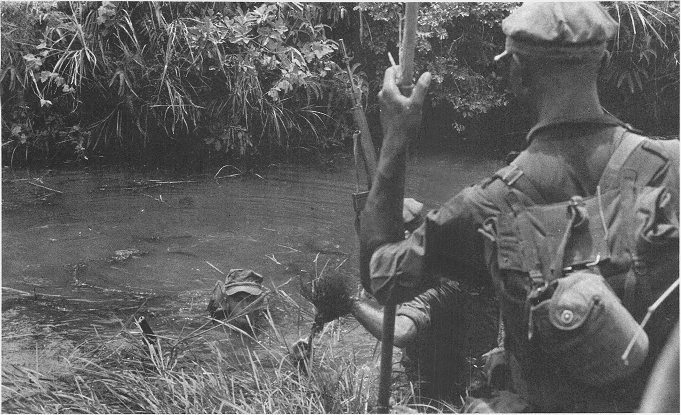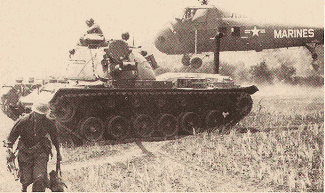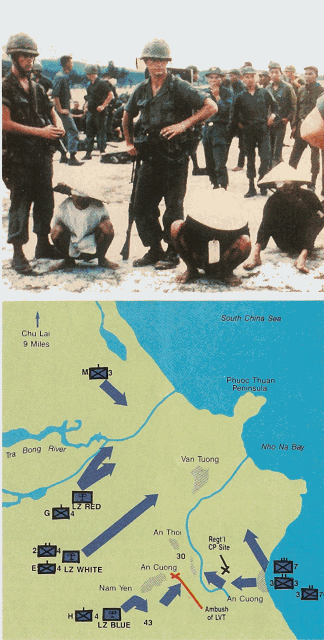A Marine from 1st Pit., Co. M, 3rd Battalion, 4th Marines, gets a helping hand out of the stream during
a sweep-and-clear mission in the Hue-Phu Bai district along the Nong River on July 27, 1965.
Just as Purnell's men were departing An Cuong No.2, gunship from VMO-2 (Marine Observation Squadron) crashed northeast of the hamlet as a result of small-arms fire. transmitting the information to the CP, Muir ordered the young lieutenant to use a squad, augmented by three tanks, to guard the downed chopper. In the distance, the leathernecks of Hotel 2/4 could be seen advancing in their direction. Purnell informed this group to attach themselves to Jenkins' command as soon as they reached them. But, on this day, the "Magnificent Bastards" would not reach their destination.
Late in the morning, Hotel riflemen left Hill 43 and crept slowly eastward heading for Nam Yen No.3 following the Ontos and tanks. Mistakenly thinking India 3/3 had just cleared the ville, Jenkins intended to bypass it. As the strung-out company reached an open rice paddy sandwiched between Nam Yen No.3 and An Cuong No.2, the 60th VC Battalion let loose a broadside upon the unsuspecting Marines. The sides of the grass huts fell down, revealing hidden machine gun nests nestled in the hootches. This strategic junction separating 3/3 from 2/4 was honeycombed with trenches, underground bunkers and spider holes. Gunnery Sergeant Victor Nunez remembers vividly: ''As we came nearer, snipers opened up and then all of a sudden all hell broke loose. It seemed a whole damn division of VC was out there waiting for us. Those bastards had us zeroed in [with] machine guns, mortars, recoilless rifles, rocket-propelled grenades, and I don't know what else. [I] saw a lot of our guys get hit ... the Company CP was hit hard, too ... our Company Gunny was killed also.''
The Marines were fighting for their lives. Unable to maneuver in the thick mud of the rice paddies, the armor was drawn into a tight circle, western style. Jenkins sent one squad to the northwest corner of Nam Yen No.3 to try and outflank the enemy. After knocking out a VC mortar crew, the Marines themselves were boxed in. Placing the wounded in a clearing to await the medevac choppers, they came under fire from VC pouring automatic-weapons fire from behind a line of dense hedgerows Lance Corporal Joe C. "J.C." Paul, a 19year-old baby-faced fire team leader, raced across a dried up rice paddy and lodged himself between the enemy and his squad, delivering accurate fire to allow the helicopters to evacuate the wounded. Although hit several times, Paul continued his suppressive fire. He died while en route to the hospital. He would be awarded the Medal of Honor for his bravery.
Jenkins, in the meantime, ordered a withdrawal to LZ BLUE. To cover his retrograde movement, jets were summoned to rake Nam Yen No.3 and Hill 30, an undersized pimple just north of An Cuong No.2, where the savage crossfire was coming from.
By early afternoon, Hotel Company was ready. However, the point platoon veered off course as medevac "birds" attempted to land within the company and take away additional wounded. Isolated from the main body, the platoon luckily found India Company's security detail still at the wreckage of the Huey. Together, this polyglot force decided to fight their way to An Cuong No.2. As the vigilant "grunts" went forward, one machine gunner, Lance Corporal Ernie Wallace of Hotel Company, thought something seemed out of place with the trees nearby. Then it hit him like a thunderbolt: "Start killing trees:' he screamed. The alert Wallace had spotted VC guerrillas sitting on their haunches behind the shrubbery.
Taken completely by surprise, every enemy soldier was killed as bullets whined and snapped into the tree line. Wallace "fearlessly moved into an exposed position, firing his machine gun from the offhand and assault positions at close range, delivering such devastating fire into the stunned adversary that he personally accounted for 25 dead enemy, allowing the squad to maneuver to a more advantageous area:' He would receive the Navy Cross.
Heroism was commonplace rather than the exception. In action elsewhere, some of the Marines attacked enemy trenchlines.
A six-man heli-team, including mortar and radioman, double-times it to the chopper.
The Sikorsky UH-34D helicopter was a Marine mainstay during Operation STARLITE,
but the Marines soon learned how hot the Viet Cong could make things.
Private Sam Badnek ran 45 yards through a murderous crossfire and flung grenades at VC emplacements. He, too, was awarded the Navy Cross. Corporal Richard Tonucci and Pfe. Ronald Centers wiped out a .50-caliber machine-gun nest by outflanking it and pitching grenades through an opening in the top of the bunker. They both were awarded Silver Stars. Nearby, Corporal Robert O'Malley, a squad leader with India Company 3/3, leaped into a trench alone and single-handedly killed eight Viet Cong caught completely unaware. Thrice wounded, the stubborn New Yorker steadfastly refused medical attention until every Marine was treated and put aboard choppers. He would survive to have the Medal of Honor draped proudly around his neck.
Reaching LZ BLUE with the main body, Jenkins conversed with "Bull" Fisher via radio and was instructed to set up a tight defensive perimeter and hang on for reinforcements to bolster his depleted ranks. Unknown to both of them, the additional troops slated for them were experiencing difficulties of their own-they were ambushed 400 meters west of An Cuong No.2. This mobile (LTV) supply column had gotten lost in the area of Nam Yet No.3 and An Thoi No.2. As the lead vehicle went around a turn, a recoilless rifle round slammed into it. As the tank shuddered to an abrupt halt, mortars began to cascade upon the Marines. A hot fire fight ensued. Major Andrew C. Comer, 3/3's Executive Officer, took the call for assistance: "The LVT operator kept the microphone button depressed the entire time and pleaded for help. We were unable to quiet him sufficiently to gain essential information as to their location. This continued for an extended period, perhaps an hour."
Lieutenant Colonel Muir, without hesitation, told Comer to "gather support" and "rescue them as rapidly as possible." Informed of the attack, Peatross deduced that the VC were attempting to drive a wedge between Hotel Company and the supply detachment to spearhead a drive upon the regimental CP at the beach. If successful, the Marines would be caught with their backs to the sea.
Gathering Company I, 3/3, one M-48 tank, an LVT and an Ontos, Comer started his sojourn to rescue to rescue the beleaguered leathernecks. Fortunately, a staff sergeant, one of the flame-thrower tank operators of the first supply column, had broken through and reported he could guide Comer's party to the ambush area.
Approaching Hill 30, the tank took the lead. As it reached the top, a shell from a 57mm recoilless rifle stopped the clanking machine in its tracks. A traffic jam resulted and, as with the first column, this one, too, was in serious trouble. Comer responded with air and artillery strikes on his hidden foe and the firing subsided after three hours of relentless combat, but sporadic sniper rounds were everywhere. After the original supply group was saved and casualties cared for, Comer left India 3/3 at Hill 30 to safeguard the wounded. Moving on, the remainder of his command entered An Cuong No.2 and discovered the isolated platoon from Jenkins' company and the lone squad from India 3/3.
At this point, the Marines caught a fusillade from the Viet Cong stemming from a wooded area to their right. Comer later remarked: ", .. it was obvious that I could not move the 'B' group [the command group] in either direction, ... I radioed instructions to Lieutenant Purnell to extricate the supply column as rapidly as he could, as I deemed that the most urgent matter!'
Peatross, alarmed at the growing gravity of the situation, wanted to deploy the SLF positioned offshore. Lieutenant General Victor H. "Brute" Krulak, Commanding General, Fleet Marine Force, Pacific, had flown in to witness the progress of the operation as "rifle and recoilless rounds were flying around." General Karch, also there, told Peatross to have him (Krulak) "obtain permission to employ 3/7.” However Krulak's chopper was forced down with a bullet in its gas tank. Finally granted approval, Captain Ronald A. Clark's Company L, 3rd Battalion, 7th Marines, was heli-lifted from the LPH IWO JIMA and put under Muir's control. Without delay, Clark's men were to be sent to boost Comer's band until they learned the supply column was out of immediate danger for the time being. So, the fresh unit was dispatched instead to Phase Line BANANA and tied in with Companies K and L, 3/3, for the night. Close behind Clark's riflemen were India and Mike Companies 3/7.
TOP: As contact is made with the Viet Cong and those entrenched in better-prepared positions elect to hold, a 105mm gun of the 3rd Marines pours in fire support at a rate of three rounds per minute.
ABOVE: A Marine drags a dead Viet Cong past a woman and her child during a village sweep near Chu Lai in 1965.


With the added manpower filtering in from the ships, the 60th VC Battalion finally broke contact and retreated. Throughout the night, the bright glare emitted from the illumination shells from the destroyers in the South China Sea kept the terrain well lit for the jittery Marines huddled in their fighting holes. As one Marine can attest to: "During the night 3/7 landed and approached our lines with: 'Please don't shoot, this is India 3/7 coming in .. .' "
With the supplementary forces at his disposal, Peatross could now breathe a sigh of relief. He adjusted the battalion's boundaries and took steps to complete the envelopment of the Viet Cong within the ring he had formed to crush them.
The following morning, August 19, the SLF battalions departed the regimental CP headed for An Cuong No.2. Meeting no resistance, the leathernecks reached the supply column survivors and established a barrier to hamper the escape of any fleeing Communist troops at An Thai No.2. Small pockets of Viet Cong remained, but the heavy combat was over. As 3/7 flushed stragglers from their spider holes and caves, the "Magnificent Bastards" of Hotel Company 2/4, after a harrowing 48 hours, were relieved, and boarded an LST for Chu Lai. Their part in STARLITE was over. The remaining companies of Fisher's battalion, Echo and Golf, joined with 317 to "squeeze the vise around the VC and drive them towards the sea." By nightfall, 2/4 had completed its sweep of the Phouc Thuan Peninsula.
General Walt issued orders to extend STARLITE an additional five days to assure that all enemy resistance had been terminated. Lieutenant Colonel Kelly's 1/7 was summoned from Chu Lai to perform this chore, while the other battalions were transported back to resume their defensive work and have a much-needed rest. On August 24, at 2100 hours, Operation STARLITE officially ended.
Over 600 Viet Cong were killed during the week-long invasion of the 1st VC Regiment's lair. Some claim this figure was much higher because numerous caves and subterranean bunkers utilized by the enemy were sealed shut by combat engineers. Also, over 100 weapons, the majority of Chinese and Russian make, were seized. The Marines sustained 45 dead and 203 wounded during the battle.
Certainly the fighting spirit of the leathernecks cannot be denied. When the situation appeared hopeless and confused, the infantrymen rose to the occasion and adapted magnificently, equaling their counterparts in World War II and Korea. Close air support also played a significant role in defeating the Viet Cong, as General Walt later stated: "It was an outstanding professional performance of the highest order. Strafing was done within 200 feet of our pinned down troops .... I have never seen a finer example of close air support."
Perhaps the entire exercise can best be summed up by Colonel Peatross: "Three factors contributed to the success of STARLlTE: Accurate information, speedy reaction to the information, and the secrecy under which the operation was conducted. But, important as these factors are, the credit really belongs to the doctrine, tactics, techniques, and training of the amphibious forces."
The Vietnam conflict was entering a new phase.
There would be many large-scale operations in the years to come. But STARLITE would have the distinction of being the first.
Both Robert A. Lynn and Albert Hemingway are Vietnam veterans and have contributed regularly to VIETNAM Magazine.



Photo below just a few days prior to Op Starlite: from Charlie Fink
India Co. 3rd Platoon, 3rd Squad